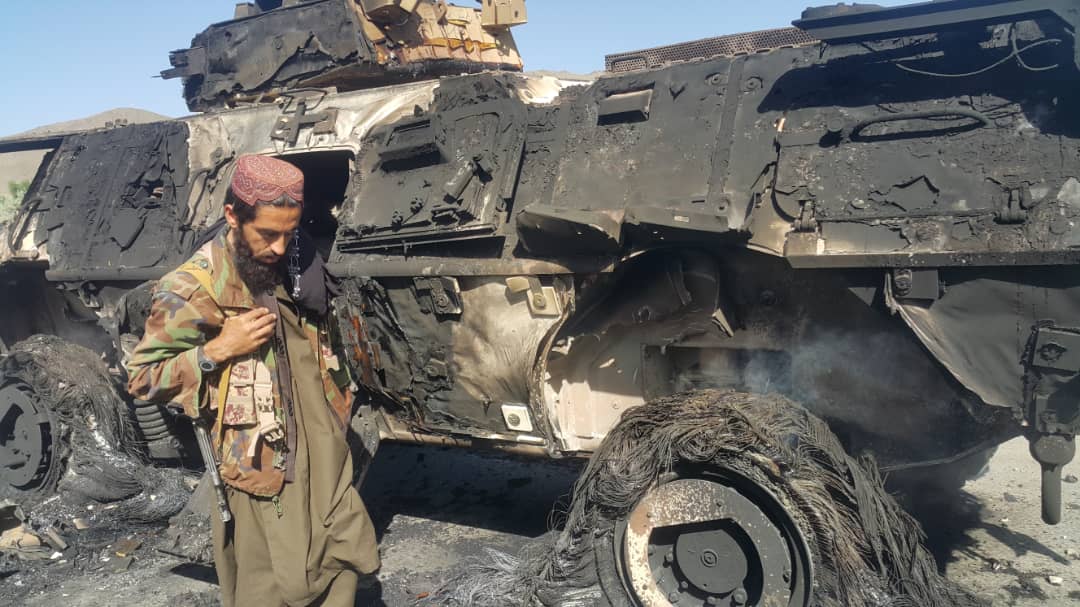El articulo documenta una lista detallada de los equipos destruidos y capturados del Ejército Nacional y la Policía Nacional afganos desde junio de 2021 hasta el 14 de agosto de 2021. La lista incluye vehículos y equipos destruidos y capturados de los que se dispone de evidencia fotográfica o videográfica. La mayoría de los combatientes talibanes no tienen teléfonos móviles de alta gama y su departamento de propaganda no publica informes fotográficos o de vídeo sobre las capturas de equipos. Por lo tanto, la cantidad de equipo destruido es indudablemente mayor que la registrada aquí. No todo el equipo capturado intacto está operativo en el momento de la captura, y muchos HMMWV y Ford Rangers se utilizan como fuente de repuestos para mantener otros vehículos en funcionamiento.
The United States’ controversial withdrawal from Afghanistan has left it teetering at the edge of an abyss as the country is facing a nationwide Taliban resurgence. Amidst an increasingly deteriorating security situation throughout large parts of the country, fears that Taliban forces could soon overrun the entirety of Afghanistan have become all too real, possibly reverting the situation on the ground back to that before the 2001 U.S. invasion in the long term. While the withdrawal of U.S. troops and their NATO allies has been praised by some and heavily criticised by others, there is one thing seemingly everyone can agree on: the 20-year U.S.-led mission to defeat the Taliban has been an utter failure.
In the absence of U.S. and NATO forces, it remains to be seen how long the Afghan government can hold its ground against an enemy that continues to take control of ever more parts of the country, their confidence bolstered by a lack of response from the Biden administration. With direct U.S. air support, intelligence assets and logistical support soon unavailable to the Afghan military, its forces will have immense difficulty in confining Taliban forces to their current areas of control. The possible withdrawal of U.S. contractors still attached to the Afghan military can only exacerbate the situation, and would likely ground much of the Afghan Air Force within weeks after their departure.
Similar to its withdrawal from Iraq in 2011, the U.S. leaves behind a broken military apparatus that despite the investment of tens of billions of dollars is ill-prepared to face the tasks assigned to it. The immense amount of equipment provided to Afghan security forces over the past two decades is hard to overstate, numbering some 25.000 HMMWVs ‘Humvees’ alone. Although an impressive number in and of itself, a lack of protection against improvised explosive devices (IEDs) means that these vehicles offer little of the protective capabilities of MRAPs available to NATO forces in Afghanistan. Astonishingly, while such MRAPs were made readily available to police departments all over the U.S., Afghan security forces have to make do without them.
The situation Afghanistan faces after the U.S. withdrawal is scarcely an isolated incident in modern U.S. history however. After effectively abandoning its ally South Vietnam in the 1970s, leaving behind a paralysed Iraq in 2011 and now withdrawing from Afghanistan, homecoming celebrations will be tainted by the grim prospects of those suffering the consequences of the War in Afghanistan for decades to come. The zealousness with which these military interventions are begun is only matched by the degree of subsequent indifference to the fate of the country when the realities of conflict become too uncomfortable, setting the stage for an endless repeating tragedy of interventionist disasters. Meanwhile, the local population is for generations to come unwillingly indebted to the whims of U.S. politics, a debt ironically incurred by the equally unwilling investment of trillions in American taxpayer dollars in the industry of war.
The haphazardness with which the U.S. is leaving Afghanistan is further illustrated by a lack of any agreement on who will run Kabul International Airport (IAP), with Afghan security forces currently not up to the task of doing so themselves. One of the countries designated to pick up the pieces is Turkey, which has been running operations at Kabul IAP since 2015 and has offered to run and protect the airport in the future as well if provided with enough logistic and financial assistance. Securing Kabul IAP and its immediate surroundings is vital to maintain flight operations in and out of the country, with diplomatic missions and development organisations otherwise shunning the embattled country.
For Turkey, increasing its involvement in Afghanistan could be tied to the easing or removal of U.S. sanctions in place on the country over its purchase of the S-400 missile system. As the only Muslim, Middle Eastern member of NATO, Turkey is perhaps best positioned to encourage all political actors to garner consensus for a durable Afghan peace to finally come to fruition. Turkish support will be vital in keeping Afghanistan open for business and at the same time send a strong signal to the Taliban that the Kabul area is not theirs for the taking.
Fuente: https://www.oryxspioenkop.com


